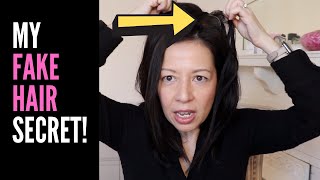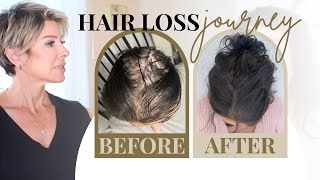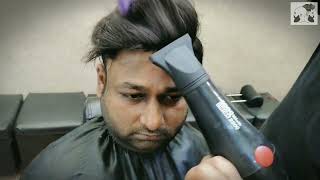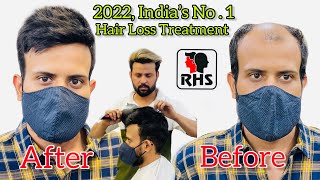Receding Hairline in Female: Causes, Prevention and Treatment
- Posted on 02 January, 2021
- Hot Topic
- By SNY Admin
You rarely see women getting bald unlike men. Although the data shows males have a higher percentage of hair loss (alopecia) compared to females, they do get them, even looking for solutions cosmetically like scalp micropigmentation services for ladies.
The content of this article is to thoroughly discuss what every woman must know about receding hairline, its symptoms, causes, preventions, and treatment, to ensure healthy hair follicles keep growing in long term. In other words, here’s what you can do if you have uneven hairlines or hair loss.
Signs and Symptoms
Losing hair is an everyday occurrence that happens as part of a normal conditions for most people; it is normal to lose approximately 100 hairs a day. The hair thinning slowly and gradually falls out, then new hair grows back again. But some circumstances may point to a possibility that receding hairline in women is problematic when it exceeds the normal count.
Signs and symptoms of hair loss may include:
- Gradual thinning hair on top of head. This is the most common type of hair loss, affecting people as they age. In male pattern baldness, hair often begins to recede at the hairline on the forehead. Women typically have a broader thinning hair all over their head.
- Circular or patchy bald spots. Some men and women lose hair in circular or patchy bald spots on the scalp, beard or eyebrows. Your skin may become itchy or painful before the hair falls out.
- Sudden loosening of hair. A physical or emotional shock can start hair to loosen. Handfuls of hair may come out when combing or washing your hair or even after gentle tugging. This type of hair loss usually causes overall hair thinning but is temporary.
- Full-body hair loss. Some hair loss conditions and medical treatments, such as chemotherapy for cancer, can result in the loss of hair all over your body. The hair usually grows back.
- Patches of scaling that spread over the scalp. This is a sign of a ringworm. It may be accompanied by broken hair, redness, swelling and, at times, oozing.
Causes and Treatments
These are multiple causes of receding hairline or thinning hair in women and each conditions are followed by their respective treatment.
- Androgenetic alopecia A very common cause of hair loss which is another term for male or female pattern baldness. Men tend to lose hair from the temples and center part of the head. In women, hair usually becomes thinner all over the head. If one has a family history of male and female pattern baldness, chances are high you have too.It is more likely to happen as a person ages but can start at any point after puberty. Many females who experience androgenetic alopecia develop it after going through the menopause. This means that hormones may have something to do with hair loss in women.
- Telogen Effluvium Telogen Effluvium causes more hair to fall out, sometimes in handfuls, this is an estate where the hair remains in the natural shedding phase of the growth cycle. Usually, telogen effluvium is a temporary form that resolves over time, such as, surgery and childbirth. It is advisable to see a doctor to find out the cause.
- Anagen Effluvium Anagen Effluvium causes large amounts of hair to fall out rapidly during the growth phase of the hair cycle. The condition may cause hair to fall out from the head, as well as from other parts of the body, including eyebrows and eyelashes, just like chemotherapy treatment.
- Alopecia areata Alopecia areata is an autoimmune condition that causes hair to fall out suddenly. The immune system attacks hair follicles, along with other healthy parts of the body. Hair from the scalp, as well as eyebrows and eyelashes, may fall out in small chunks.
- Traction alopecia A receding hairline due to hairs being pulled back into tight hairstyles. Traction alopecia causes it to break and come loose.Include:
- Tight buns or ponytails
- Braids
- Medications Some medications have side effects that can start hair to fall out.Examples of such medications include:
- blood thinners, such as warfarin
- Accutane, to treat acne
- antidepressants, including Prozac and Zoloft
- beta-blockers
- cholesterol-lowering drugs, such as Lopid
- Frontal Fibrosing Alopecia Frontal fibrosing alopecia typically occurs in a receding hairline pattern and may also result in hair loss in the eyebrows and underarms. Frontal fibrosing alopecia most commonly affects post menopausal women.
- Birth control pills Hair loss while using birth control pills may be a bad experience to some people. Others might suffer hair loss several weeks or months after they stop taking them. If people are taking birth control pills, they can choose one that has a low androgen index. This may help to lower the risk of hair loss. Other forms of birth control that give hormonal changes, such as implants and skin patches, may also cause hair loss.
- Ringworm Ringworm is a fungal infection that can start hair loss. Ringworm on the scalp, or tinea capitis, can cause temporary bald areas on the head, its symptoms include: itchy, red patches of skin, small spots that get bigger and many more.
- Polycystic ovary syndrome (PCOS) A condition that affects a woman’s hormone levels. Women with PCOS produce higher-than-normal amounts of male hormones. This hormone imbalance causes them to skip menstrual periods and makes it harder for them to get pregnant. Its symptoms include hair loss, depression, and acne. Its risk factors infertility, diabetes, and obesity.
Treatment:
It is possible to treat this condition with a medication for hair growth, namely minoxidil twice every day.Treatment:
A doctor will need to treat any underlying causes of telogen effluvium. If a physician suspects that specific medications are causing hair loss at any form, they may change them.Treatment:
Treatment for this condition depends on the cause but can include a topical solution of minoxidil. If a person has anagen effluvium as a result of undergoing chemotherapy, cooling the scalp during the procedure may help. Hair will often grow back 3–6 months after stopping chemotherapy.Treatment:
If a person has this state of being, they should see a physician. A doctor may prescribe medication to help the hair grow back.Treatment:
In terms of self-care, avoiding tight hairstyles will usually prevent further damage.Treatment:
If a person thinks hair loss may be due to a medication they are taking, they should consider seeing a physician for an assessment. The doctor might be able to reduce the dosage or switch the person to a different medication.Treatment:
Certain medications can manage symptoms and stop the progression of the disease. The cause is unknown.Treatment:
The American Hair Loss Association recommends that people who have an increased risk of genetic hair loss opt for a non-hormonal type of birth control.Treatment:
If ringworm does not heal by itself, then a doctor may prescribe an antifungal medicine. Alternatively, they may prescribe an antibiotic, such as Griseofulvin.Treatment:
There is no cure for PCOS, but you can manage the symptoms of PCOS with the help of your physician.Regrowing hairline
There are a lot of ways to regrow hairlines from scalp massages to taking supplements, and eating a healthy diet. Here are the best and advance methods of the doesn’t require much patience:
Hairline lowering/advance procedure
The hairline lowering/advancement procedure is performed by your surgeon making a trichophytic incision along the natural hairline and then carefully moving the scalp forward and downwards on the forehead. The hair-bearing tissue is then moved forward and sutured into its new lower position. After suturing, the individual hair follicles may also be transplanted to fill in gaps and to ensure that the hairline is natural.
Hair transplant
The use of hair transplantation also works to normalize the shape of the new hairline and also to minimize the appearance of any scarring as hair growth manifests through and over the incision line. In most cases, after the hair transplants surgery, there are only a very minimal, barely visible scars at the hairline. This scar will eventually fade to become nearly invisible over time.
Plasma Injections
Here’s one we hadn’t heard of before. Platelet-rich plasma injections (PRP) have been used in other fields of medicine for over a decade but have only reached dermatology within the last five years. Simply put, Blood is extracted from the person with hair loss and ‘growth factors’ are extracted from the blood, then injected back into the scalp in the area where hair loss is occurring.
Scalp micropigmentation
During the scalp micropigmentation process (SMP), specialists apply an ink to a balding area with microneedles, which create micro impressions to give the illusion of hair. The ink helps replicate the appearance of thicker hair and each formula is mixed to match a person’s natural hair color as much as possible. The best people to ask, how scalp micropigmentation help hair loss is the Scalp International Hairlines, for they are the best professional to choose for your receding hairline problem and, every client that is treated will not leave the final session of treatment without being 100% satisfied – guaranteed!
Scalp International Hairlines based in New York City, business interest is hair restoration, a service they value from the heart. Your health information, such as blood pressure, heart disease or any disorder will be treated confidentially. The privacy settings of this media websites will ensure your personal data use is protected. The ad and content measurement audience insights and product development ensuring security, preventing fraud, and debug. For full site experience visit the Scalp International Hairlines website.
Bottom line
In male pattern hair loss (MPHL), the hair loss typically presents itself as either a receding front hairline, loss of hair on the crown (vertex) of the head, or a combination of both. Female pattern hair loss (FPHL) typically presents as a diffuse thinning of the hair across the entire head.
Either way, there is no doubt that hair loss or even receding hairline affects both men and women’s psyche. This psychological toll affected the woman more that men, obviously. Female pattern hair loss may lead to depression, anxiety, and social phobia.
Don’t lose hope! Hair growth will come to the one who is patient.




